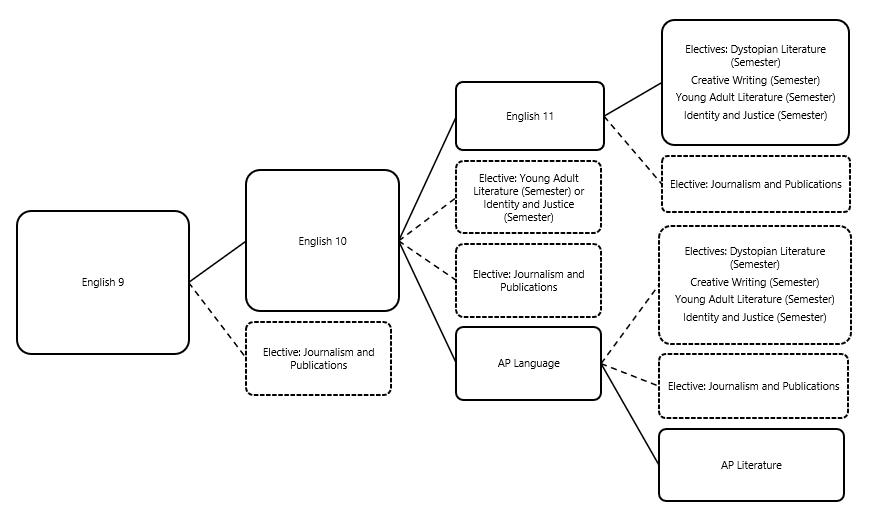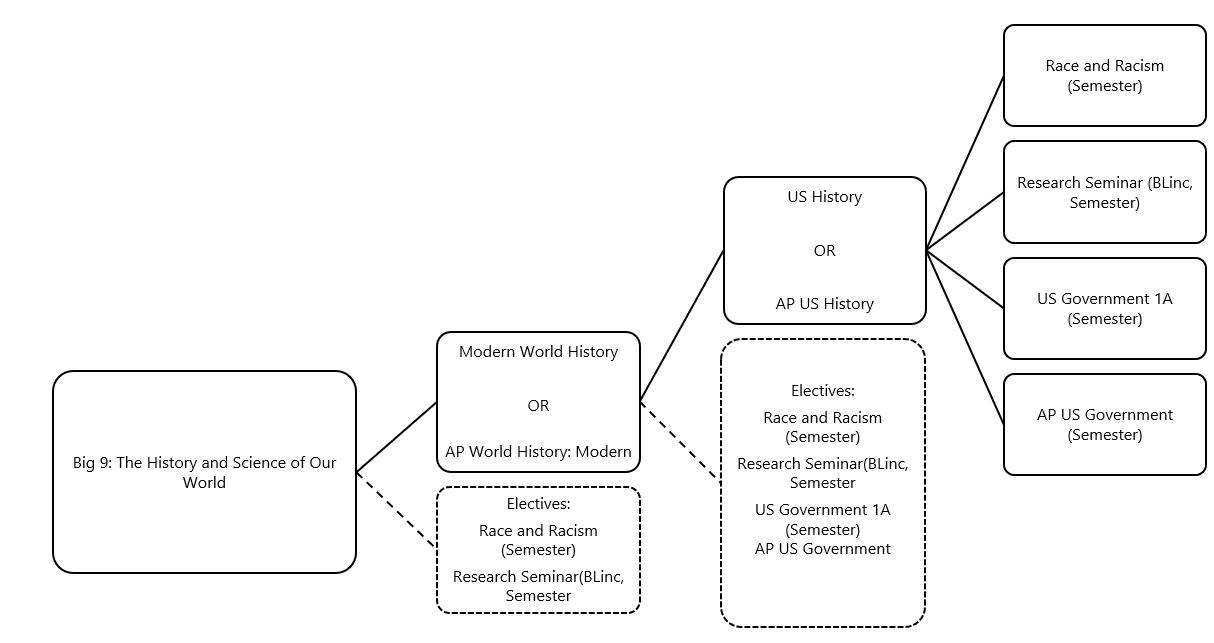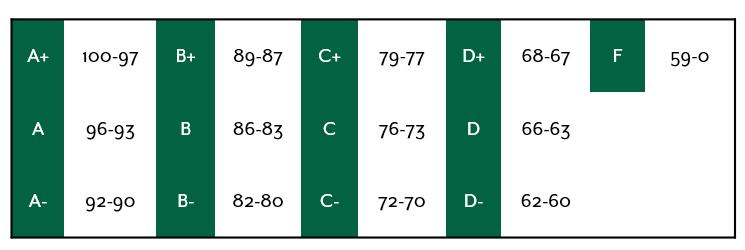
8 minute read
SCIENCE
Science
Course Sequence
Advertisement
The History and Science of Our World (Earth Science)
Note: This is a required course for all ninth graders starting with the Class of 2025. This course awards students both a history and science credit and is taught as a “double-block” taking up two class periods. Students explore diverse science and humanities through a carefully crafted and interdisciplinary curriculum to get a bigger sense of the stories of Us, the creation of the universe, and the ascent of mankind. Students create “Big Questions”, design research, and claim test theories, while developing thinking skills, mindsets, and mature study skills which will set them on the path to maximize their Upper School experience. The course is designed in conjunction with the grade 9 English experience to combine the best of a curated interdisciplinary model across these disciplines. From the Big Bang to the Enlightenment, students will be challenged to consider diverse human conditions and issues, allowing them to form their personal responses to parallel questions in the modern world. As this course covers both the History and Science of our World, it receives both a science and a history credit. 9
Biology (Life Science)
Students in this laboratory course study the basic principles of biology from chemical structures of biomacromolecules to global connections in biogeochemical cycles. Units on modern tools and research, ranging from genetics and biotechnology to evolution, introduce students to future directions in the field.
ICS recommends students take Physics, Chemistry, and Biology in that order before taking upper-level science electives. Students may double up on two of these courses in any year if they wish. Students are required to take Big 9 (starting with Class of 2025), Physics OR Chemistry, and Biology to graduate. 10, 11, 12
Chemistry (Physical Science)
Prerequisite: Algebra 1 Topics students explore include atomic structure, nuclear processes, bonding, acids and bases, and the nature of various substances. Students have ample opportunity for problem solving (i.e., “doing” chemistry, not merely memorizing), for investigating chemistry in their own lives, and for examining the implications of chemistry for contemporary social and technological issues. Students learn the scientific method of questioning, observation, organizing data, hypothesizing explanations, making predictions, and testing theories to determine their validity.
ICS recommends students take Physics, Chemistry, and Biology in that order before taking upper-level science electives. Students may double up on two of these courses in any year if they wish. Students are required to take Big 9 (starting with Class of 2025), Physics OR Chemistry, and Biology to graduate. 10, 11, 12
Physics (Physical Science)
Physics is the study of motion and change. Through frequent laboratory investigations, students build conceptual models to explain and predict the behavior of a wide range of physical systems, from atoms to soccer balls to planets and stars. Iterative analysis of motion and the use of conservation principles are key threads that run throughout the course. These ways of thinking give students insight into how changes in the energy and momentum of physical systems occur and are constrained. Students also code and use simple computational models to explore the behavior of more complex phenomena. Topics include gravitation, electricity, magnetism, sound, light, and heat. ICS recommends students take Physics, Chemistry, and Biology in that order before taking upper-level science electives. Students may double up on two of these courses in any year if they wish. Students are required to take Big 9 (starting with Class of 2025), Physics OR Chemistry, and Biology to graduate. 9, 10, 11, 12
AP Physics 1
Prerequisite: Students choose between Physics and AP Physics (i.e. Physics is not a pre-requisite for AP Physics). Students in AP Physics 1 should be concurrently taking Precalculus, although Algebra II students
with strong mathematical ability may take the course at the discretion of the instructor. Students taking Calculus are strongly encouraged to take AP Physics C rather than AP Physics 1. Physics is the study of motion and change. Through quantitative laboratory investigations, students in AP Physics 1 develop and use conceptual models to study physical phenomena. Interactions between objects can change three fundamental quantities: momentum, energy, and angular momentum. Students apply this small set of principles to explain and predict the behavior of a wide range of physical systems, from atoms to soccer balls to planets and stars. A particular focus is the use of computation to model the behavior of complex systems. Modern physics is integrated into the curriculum: students study atomic models of matter, quantized energy, and relativistic dynamics. Students in AP Physics 1 do not need to know or use the methods of calculus, although they will often encounter calculus-related ideas during the course. ICS recommends students take Physics, Chemistry, and Biology in that order before taking upper-level science electives. Students may double up on two of these courses in any year if they wish. Students are required to take Big 9 (starting with Class of 2025), Physics OR Chemistry, and Biology to graduate. 10, 11, 12
Electives
Anatomy and Physiology
Note: This course will not be offered in 2021-22. Prerequisites: Biology and Chemistry A study of the human body emphasizing the complementary nature of structure and function, molecular and cellular interactions, homeostasis, and metabolic processes. Includes a study of cells,
tissues, membranes, and several major body systems. Health related career opportunities are also explored. Animal dissection is a requirement for the course. 11, 12
AP Biology
Prerequisites: Chemistry, Biology, and Algebra 1 This laboratory-based course builds on concepts learned in Biology. Students engage in an in-depth study of biological concepts typically learned during a first-year college Biology course for majors. Upon completion of this course, students should gain an appreciation for evolution, energy transfer, continuity and change, relationship of structure to function, regulation, interdependence in nature, and science, technology, and society. 11, 12
AP Chemistry
Prerequisites: Chemistry and Algebra 2 AP Chemistry is an introductory college-level chemistry course. Students cultivate their understanding of chemistry through lab-based investigations as they explore the four Big Ideas: scale, proportion, and quantity; structure and properties of substances; transformations; and energy. 11, 12
AP Environmental Science
Prerequisites: Biology, and either Physics or Chemistry. AP Environmental Science engages students with the scientific principles, concepts, and methodologies required to understand the interrelationships within the natural world. The course requires that students identify and analyze natural and human-made environmental problems, evaluate the relative risks associated with these problems, and examine alternative solutions for resolving or preventing them. Environmental science is interdisciplinary, embracing topics from geology, biology, environmental studies, environmental science, chemistry, and geography. 10, 11, 12
AP Physics C Mechanics
Prerequisite: Students in AP Physics C Mechanics should either be currently taking AP Calculus AB or BC or have taken a calculus course in the past. Physics is the study of motion and change. Through quantitative laboratory investigations, students in AP Physics C Mechanics develop and use conceptual models to study physical phenomena. Interactions between objects can change three fundamental quantities: momentum, energy, and angular momentum. Students apply this small set of principles to explain and predict the behavior of a wide range of physical systems, from atoms to soccer balls to planets and stars. A particular focus is the use of computation to model the behavior of complex systems. Modern physics is integrated into the curriculum: students study atomic models of matter, quantized energy, and relativistic dynamics. Students in AP Physics C Mechanics study how derivatives, integrals, and differential equations give additional insight into fundamental principles. 11, 12
AP Physics C Electricity and Magnetism
Prerequisites: Completion of AP Physics 1 or AP Physics C Mechanics. Students in AP Physics C E&M should also either be concurrently taking AP Calculus BC or have taken it in the past. Through quantitative laboratory investigations, students in AP Physics C E&M extend models from previous AP Physics courses to include the study of electric and magnetic interactions. The concept of a field is central to modern physics, and students examine in detail how electric and magnetic fields interact with matter.
Atomic models are broadened to include the behavior of electrons, with a focus on electrical conduction in circuits. Students also learn how delayed changes in fields lead to the propagation of electromagnetic radiation, and how descriptions of electromagnetic phenomena are unified under Maxwell’s equations. Students in AP Physics C E&M repeatedly apply the tools of calculus to analyze phenomena. As in earlier courses, computation is used extensively to model the behavior of complex systems. 11, 12
AP Psychology
The AP Psychology course is designed to introduce students to the systematic and scientific study of the behavior and mental processes of human beings and other animals. Students are exposed to the psychological facts, principles, and phenomena associated with each of the major subfields within psychology. They also learn about the ethics and methods psychologists use in their science and practice. The Advanced Placement Program offers a course and exam in psychology to qualified students who wish to complete studies in secondary school equivalent to an introductory college course in psychology. 11, 12
Astrophysics (Semester)
Prerequisite: Physics or AP Physics (any level) How are stars born, and how will they die? How do we know that almost every star has planets? And yet why might most planets be “rogue”? What causes galaxies to form and evolve, and why will none of them last forever? Students in this course study how astrophysicists formulate and answer such questions about incredibly distant objects. A particular focus is the ongoing study of exoplanets, and the related questions about the prevalence of life in our universe. A significant portion of the course is project-based, with students using computational tools to analyze source data acquired by large observatories. 10, 11, 12
Athletic Training (Semester)
This course is designed to be an introduction into the field of Athletic Training. It is meant to give an interested sports medicine student their first exposure to the sports medicine world. Emphasis is placed on musculoskeletal injuries that occur during exercise or athletic competition and on the assessment of various athletic injuries. Students will also have the opportunity to learn athletic taping, wrapping, and bracing skills. 10, 11, 12
Global Online Academy Science Offerings
Visit https://globalonlineacademy.org/student-program/student-courses and select “Science and Health” to see approved course offerings through GOA.





